Pros
Cons
Introduction
Lens & Imaging System
{{section_header}}{{section.name}}{{/section_header}}

Just like on last year's HDR-TD10, Sony's new 3D camcorder has a dual lens and dual sensor system that makes it possible to record Double Full HD 3D video. The lens has a wide aperture of f/1.8, allows for 10x optical zoom during 3D recording (12x in 2D), and has a minimum focus distance of 30cm for 3D recording (1cm for 2D). Is may not be the exact same lens setup as on last year's HDR-TD10, but the specs sure suggests they are identical.
Sony lists the dual sensor system on the HDR-TD20V as having two 1/3.91-inch CMOS chips with 5.43 total pixels. This pixel count is an upgrade over last year's HDR-TD10, and you can see the complete lens and sensor specs for that camcorder here.
Front
{{section_header}}{{section.name}}{{/section_header}}
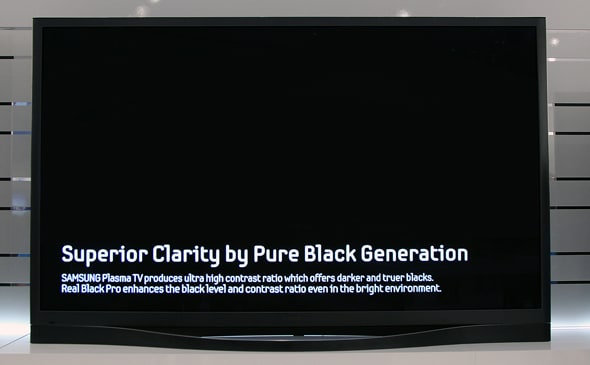
Right
{{section_header}}{{section.name}}{{/section_header}}
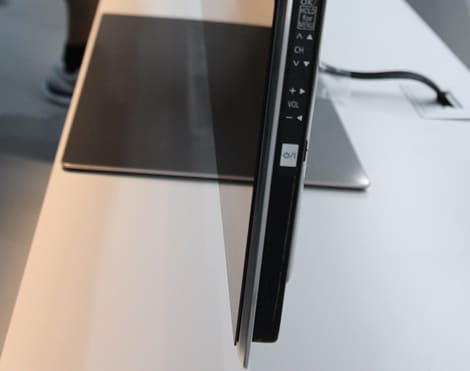
Back
{{section_header}}{{section.name}}{{/section_header}}
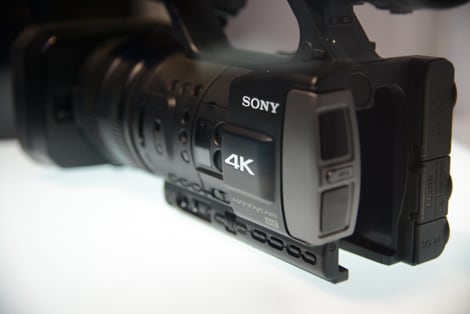
Left
{{section_header}}{{section.name}}{{/section_header}}
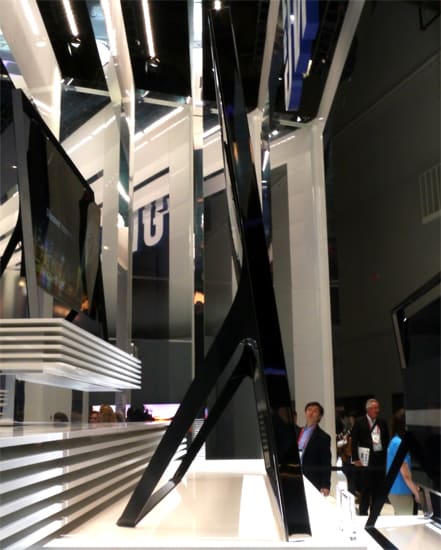
Top
{{section_header}}{{section.name}}{{/section_header}}

Bottom
{{section_header}}{{section.name}}{{/section_header}}
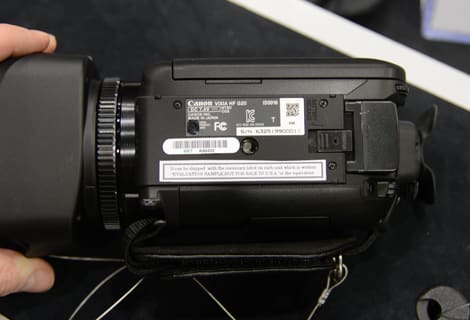
Compression
{{section_header}}{{section.name}}{{/section_header}}
As far as compression and recording options go, Sony changed little on the HDR-TD20V as compared to its predecessor. The only significant change is that Sony added the AVCHD Progressive (AVCHD 2.0) logo to the side of the camcorder, as now AVCHD has officially added standards for 1080/60p recording. Other than that official change in terminology, the TD20V has the same compression options and recording settings as the TD10. That includes 1080/60p 2D recording (with a 28Mbps bitrate), Double Full HD 3D (at a 28Mbps bitrate), two other Full HD record modes that can shoot 60i or 24p footage (FX and FH), two 1440 x 1080 settings that only record 60i (HQ and LP), and one standard definition record mode.
Read more about the advantages and disadvantages of different compression types.
Media
{{section_header}}{{section.name}}{{/section_header}}
Just like its predecessor, the HDR-TD20V is loaded with 64GB of internal flash memory and a memory card slot that works with SD/SDHC/SDXC or Memory Stick PRO Duo cards. We expected to see an upgrade to more internal memory on the new model, but 64GB is still a huge amount, so we're not complaining.
Read more about the advantages and disadvantages of different media types.

Auto Mode
{{section_header}}{{section.name}}{{/section_header}}
Sony likes to load its Handycams with all sorts of what we like to call "advanced auto" controls. So, along with its dedicated auto mode, which is called Intelligent Auto, the HDR-TD20V has a ton of scene modes, tracking functions, face detection options, and basic adjustment tools. All of the controls are available for 2D recording, but the camcorder is somewhat limited when it comes to 3D. No scene modes, no face detection, and few manual controls are available when recording 3D content on the TD20V—just as was the case with its predecessor.

Low Light Modes
Sony's popular infrared NightShot feature is not found on the HDR-TD20V, but the camcorder does have a Low Lux mode that boosts brightness in dark scenes. Low Lux is not available in 3D mode, and all it really does is boost the gain and allow the TD20V to use slower shutter speeds.
Scene Modes
The following scene modes (2D only) are available on the HDR-TD20V: Twilight, Twilight Portrait, Sunrise & Sunset, Fireworks, Landscape, Portrait, Spotlight, Beach, Snow.
Zoom
Focus
{{section_header}}{{section.name}}{{/section_header}}
The adjustment dial on the front of the TD20V lets you set a variety of manual controls, the most important of which is focus. You can also set focus using the touchscreen LCD, and the manual option for focus control is available in both 2D and 3D mode. Other focus options aren't available for 3D recording, like the AF illuminator and the focus tracking feature. You also can't perform a spot focus in 3D mode.
Exposure
{{section_header}}{{section.name}}{{/section_header}}
Exposure can also be set using the adjustment dial on the front of the TD20V, and you can set exposure by manipulating the aperture, shutter speed, or basic exposure control (with EV steps). In addition to these full manual controls, the camcorder has options for AE shift, backlight compensation, noise reduction, and face detection. Many of these controls only work for 2D recording, so if you're looking for full-fledged manual control in 3D mode, you'll have to check out a different camcorder.
White Balance
{{section_header}}{{section.name}}{{/section_header}}
There are two white balance presets on the HDR-TD20V, one for outdoor and one for indoor. There's also an auto setting and a manual white balance option. This is a fairly limited set of white balance controls for a high-end camcorder, and we'd like to see a few more presets here.
Other Manual Controls
{{section_header}}{{section.name}}{{/section_header}}
Sony's slow motion record mode, called Smooth Slow Record, is included on the TD20V, but, like a lot of the camcorder's features, it only functions for 2D recording. It allows you to record a short clip at a high frame rate, which then turns into a slow motion clip when played back. Sony has this feature on most of its Handycams.
3D Lens
{{section_header}}{{section.name}}{{/section_header}}
From what we can tell, the dual lens system on the HDR-TD20V is identical to the 3D lens on last year's HDR-TD10. You can read about the TD10 here for more in-depth information, but we'll still give an overview of what we saw with the TD20V at CES.

The dual lens system makes 3D recording a reality on the Z10000.
The camera has a built-in dual lens system, as well as two sensors, which is what enables the TD20V to capture what Sony calls Double Full HD 3D. That's two Full HD images that are overlapped to create the 3D effect. The built-in dual lens system also means there's less of a need for calibration (as opposed to Panasonic's 3D lens attachment, which does require calibration and setup when it is connected to a camcorder).
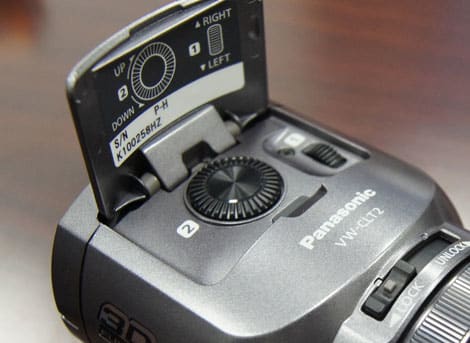
3D Controls
{{section_header}}{{section.name}}{{/section_header}}
A 10x zoom, manual focus, and manual exposure are available during 3D recording, but other controls are very limited. Many of the advanced auto functions, like focus tracking, scene modes, and smooth slow record don't function during 3D recording. So, when you shoot 3D with the TD20V, remember that you are going to be very limited with what you can control and adjust.
Since the double lens system doesn't require calibration, there isn't much in the way of 3D adjustment needed on the TD20V. There is a 3D depth control, however, that allows you to play around with the strength of the 3D effect. Using this, you can fine tune the 3D look to your liking. It's kind of a challenge to use, and it works best if you have a 3D HDTV to view your footage on for reference.
{{product.manufacturer_specs['FI 3D Physical Controls Image']}}{{product.manufacturer_specs['FI 3D Physical Controls Image 2']}}
{{product.manufacturer_specs['FI 3D Controls Menu Image']}}
3D Playback
{{section_header}}{{section.name}}{{/section_header}}
Of course you can watch your recorded 3D video on a 3D television, but to do that you need to have access to a 3D HDTV (and not many people have that). The other option is to use the TD20V's glasses-free 3D LCD to look at your 3D content, but the results aren't nearly as pretty as you'd get from a full-fledged 3D television. We've been on the record saying that Sony, with the TD10 last year and the TD20V this year, makes the best glasses-free 3D LCDs we've seen on camcorders.
We think this is partially due to the high resolution of the LCD itself (an excess of one million pixels), but it may also have to do with Sony's construction of the 3D technology. Despite the fact that the screen is better than the competition, we'd never say the quality is incredible. The 3D effect is limited on the LCD, and the angle of view is terrible—it is far worse than you'd get on a regular 3D television, period. But it will work if you're in a pinch.
{{product.manufacturer_specs['FI 3D Playback Menu Image']}}
Ease of Use
{{section_header}}{{section.name}}{{/section_header}}
Sony does a good job making camcorders that are full of controls and features, but are also relatively easy to use. By blocking out most of the controls in 3D mode, Sony may alienate some users, but it does make the TD20V simpler to use for 3D recording. You don't have to worry about making strange adjustments or settings—you can just concentrate on framing your image and hitting the record button at the appropriate time.
The manual control dial on the front of the camcorder helps a tremendous amount for people who love making precise adjustments to focus or exposure (among other things). The dial is small enough that basic users can ignore it and run the HDR-TD20V in auto mode, but its large enough that you can get a good grip on it and adjust controls to your liking. It's not a perfect solution (a lens ring would probably be better), but it is a very good feature.
Handling
{{section_header}}{{section.name}}{{/section_header}}
The biggest improvement Sony made to the HDR-TD20V was to cut down on the camcorder's bulk and reduce its weight compared to its predecessor. The camcorder is still a large device (compared to most camcorders these days), but it weighs 460g (just over a pound) and has dimensions of 63.5 x 71.5 x 141.5mm. This makes it a whopping 185g lighter than its predecessor, as well as a far slimmer and shorter model.
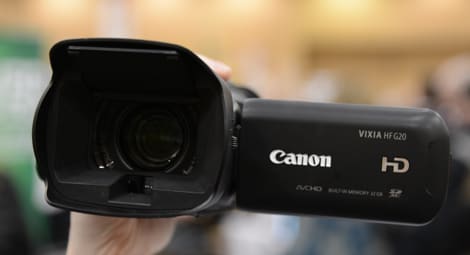
The main size reduction came by Sony removing the bulky hand grip on the right side of the camcorder. By removing this section, the TD20V is actually easier to wrap your fingers around. And there really isn't much change in the quality of the grip. We never liked the bumpy, rigid design of the grip on the TD10, so we're pleased with this improvement from Sony. The only thing we ask for is a more rounded shape to the top of the TD20V, as the camcorder still has the flat, boxy design we saw on the TD10 last year.

Either way, the shrinking of Sony's 3D camcorder is impressive and it makes us more likely to consider the HDR-TD20V as a viable option. We hated the fact that the TD10 was too bulky and it made us not want to carry it around if we were only planning on shooting 2D video. The smaller size of the HDR-TD20V is certainly more appealing for this reason, as it isn't much bigger than other flagship camcorders.

Battery
{{section_header}}{{section.name}}{{/section_header}}

LCD & Viewfinder
{{section_header}}{{section.name}}{{/section_header}}
The HDR-TD20V returns with a large, 3.5-inch touchscreen that features a glasses-free 3D display. As we've said a number of times in this review, the 3D display is not great, but Sony's is the best we've seen on a camcorder so far. It's good for getting an idea of what the 3D effect will look like, but it won't look nearly as good as viewing 3D content on an actual 3D HDTV. The screen's impressive resolution and size also make it a great tool for framing your shot during regular 2D recording. Remember, there's no viewfinder on the camcorder, so the LCD will have to be your best friend for framing and recording your videos.



Audio Features
{{section_header}}{{section.name}}{{/section_header}}

Connectivity
Conclusion
A lot of the time when we see new products at CES, we come away disappointed that there aren't enough updates or new features to make us excited. Manufacturers often love to "re-release" camcorders with a few design changes and mildly improved specs that translate to little improvement in performance or handling. We're hinting that the Sony HDR-TD20V may be this kind of camcorder, although we can't say for sure until we get the model into our labs for a thorough test.
Here are the important changes Sony made to the new HDR-TD20V as compared to last year's HDR-TD10. The camcorder has a slightly altered image sensor with a higher pixel count, there was some rearrangements of ports, the addition of GPS, and—most importantly—a huge reduction in size and weight. It's this shrinking of the camcorder that excites us most, other than the possibility of improved performance.
3D camcorders certainly weren't one of the hot topics at CES 2012, especially compared to last year. Sony was one of the few major manufacturers to release a new, high-end camcorder with built-in 3D capability, and the HDR-TD20V didn't add anything incredibly new to the 3D market. Maybe this is a sign that the feature is beginning to fade away... perhaps to be overtaken by the rise of 4K2K video recording instead?
Photo Gallery
{{photo_gallery "FI Lens Image", "FI Front Image", "FI Right Image", "FI Back Image", "FI Left Image", "FI Left Open Image", "FI Top Image", "FI Bottom Image", "FI Media Image", "FI Easy Mode Image", "FI Zoom Image", "FI Zoom Image 2", "FI 3D Lens Image", "FI 3D Lens Image 2", "FI 3D Physical Controls", "FI 3D Physical Controls 2", "FI Handling Image", "FI Handling Image 2", "FI Handling Image 3", "FI Battery Image", "FI LCD Image", "FI Viewfinder Image", "FI Viewfinder Image 2", "FI Playback Image", "FI Mic Image", "FI Flash Image", "FI Photo Mode Image", "FI Ports Image 1", "FI Ports Image 2", "FI Ports Image 3", "FI Ports Image 4", "FI Ports Image 5", "FI Ports Image 6"}}
Specs
{{manufacturer_specs_table}}
Meet the tester
Jeremy is the video expert of our imaging team and Reviewed.com's head of video production. Originally from Pennsylvania and upstate NY, he graduated from Bard college with a degree in film and electronic media. He has been living and working in New England since 2005.
Checking our work.
Our team is here to help you buy the best stuff and love what you own. Our writers, editors, and experts obsess over the products we cover to make sure you're confident and satisfied. Have a different opinion about something we recommend? Email us and we'll compare notes.
Shoot us an email